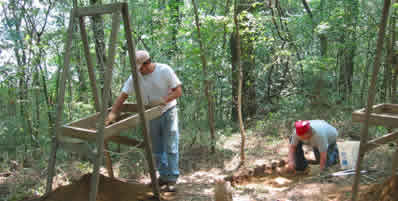Beyond City Point
Exploring Hopewell's Deep Archaeological Heritage
In 2002 archaeologists from the William & Mary Center for Archaeological Research investigated a handful of City Point properties at the request of the City of Hopewell. The impressive results of the 2002 dig confirmed our high expectations for archaeology in this well-known historic area of the city. But Hopewell also boasts a wealth of other important archaeological sites, even though few have been explored.
 We are expanding our 2003 research to other key sites throughout the city—sites of interest to visitors, scholars, and most importantly Hopewell's citizens. During the first part of the season, we will work at Weston Manor, one of the city's historic showpieces. While architectural historians have celebrated the crafstmanship and design of this late 18th-century Georgian mansion, we know little about the surrounding grounds and plantation. Archaeological and historical research will focus on landscape and outbuildings, so we can learn about life at Weston, both for the owners and for the African-American slaves who labored on the property. The second half of our field season will turn to archaeological survey of areas of the city that we believe to contain important sites. These include a very early colonial settlement called Bermuda City or Charles City (pre-1622), contemporary late Native American sites, later colonial sites like Broadway Landing and City Church, antebellum African-American sites, and an early Prince George County courthouse.
We are expanding our 2003 research to other key sites throughout the city—sites of interest to visitors, scholars, and most importantly Hopewell's citizens. During the first part of the season, we will work at Weston Manor, one of the city's historic showpieces. While architectural historians have celebrated the crafstmanship and design of this late 18th-century Georgian mansion, we know little about the surrounding grounds and plantation. Archaeological and historical research will focus on landscape and outbuildings, so we can learn about life at Weston, both for the owners and for the African-American slaves who labored on the property. The second half of our field season will turn to archaeological survey of areas of the city that we believe to contain important sites. These include a very early colonial settlement called Bermuda City or Charles City (pre-1622), contemporary late Native American sites, later colonial sites like Broadway Landing and City Church, antebellum African-American sites, and an early Prince George County courthouse.
Sponsored by the City of Hopewell. Prepared by the William & Mary Center for Archaeological Research.















